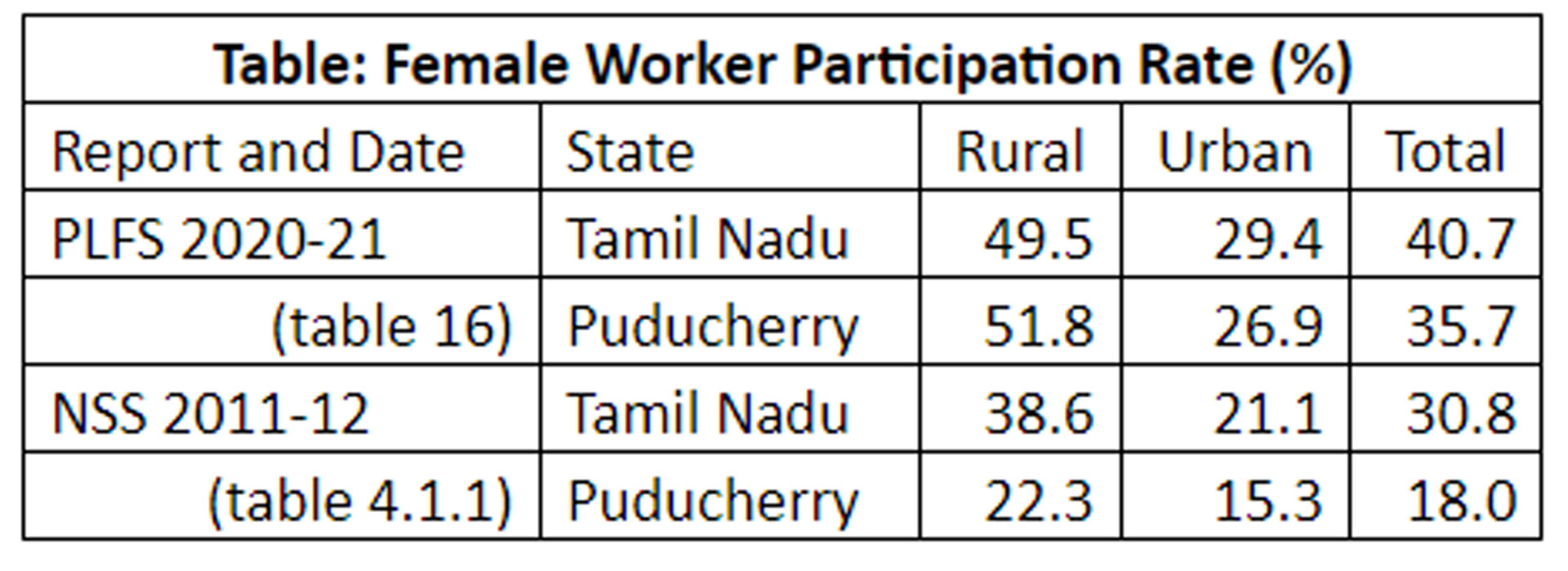The numbers are not falling on the ground, as is alleged.
Labour Force Participation Rate (LFPR) is defined as the percentage of persons in labour force (i.e. working or seeking or available for work) in the population. In the recent times there have been considerable noise around a precipitous fall in the same, especially for females. There are allegations that in the last 2-3 years it has fallen steeply from mid-40s to slightly over mid-teens.
This article is based on field comparative observations based on a road tour in 2013 and 2023 in Tamil Nadu and Puducherry. The 2013 tour covered 1,200 km and the current observations are based on three trips on three different routes covering nearly 2,600 km over the last two months. The comments are based on discussions (only in 2023) and observations (both years) of front line workers in sales outlets, eateries of various descriptions, petrol stations, security staff, cleaning or maintenance staff, temple and monument staff and police. Since the drive and the discussions and observations were through both rural and urban areas it gives a good basis of comparison.
In 2013, it would be difficult to find female crew in restaurants and eateries. If at all they were confined to high end hotels.
Out of five outlets one might have found an odd female attendant in one of them. Today the number of outlets with all female crew as observed seems well over 50%. In some of the larger towns almost every outlet was female assisted. All male crew may be less than a fourth (may be more in interior areas) and a mixed crew may be 20-30%. This is observed both in rural and urban areas. Many sales outlets have a great proportion of female employees and in some modern retail biggies all the floor assistants and billing staff are females. In 2013, one may be hard put to find a female petrol bunk dispenser; today they may be 10-15%. Similarly, one sees increased numbers of females in private security staff and police.
The accompanying table gives the official statistics for both Tamil Nadu (State)and Puducherry (Union territory). NSS 2011-12 has been taken as reference closest to the previous journey and PLFS 20-21 for current journey. Both the states (using the term loosely) show significant improvement over a decade. In Puducherry rural, FLFPR has increased 2.32 times in percentage terms, while in TN it is 1.28 times. In urban areas it is 1.75 and 1.4 times respectively. This vastly different movements in adjacent states with free mobility and arguably the best of road transport connectivity for labour mobility looks discrepant and needs to be scrutinized. Per capita incomes for TN and Puducherry in FY 2023 are Rs 241,131 and Rs 222,451 respectively. The difference in per capita income may not account for the differing movements in participation rates.
Tamil Nadu may be operating at full employment levels in a restricted sense (male workers). It is typified by the response of a female worker when asked if any male known to her is unemployed. She looked distant trying to recollect and responded, “if we search carefully, we may find somebody”. It has not only absorbed its male workers, provided work for many from Bihar, Northeast and Jharkhand but has in the recent times started sourcing from local females including interior areas. Many of the women spoken to were first time workers in their family to work in non-agricultural commercial jobs. Many have started working from middle age i.e., started working at age 30-35 after remaining outside the workforce till then, reflective of the recent demand for their services. Most were primary school or secondary school pass-outs. Clearly, local small-time employers are going in search for them. Many confirmed travelling to workplace using transport and one lonely married lady working as restaurant waitress was staying away from family to visit them only on break days. Many of these phenomena are recent or unusual.
The phobia or inertial stigma is overcome once 1 or 2 women within the surrounding community or village start working. The others shed their inhibitions and anxieties and join the workforce soon. This was articulated by one women worker, whose husband became incapacitated and immobile due to an accident 9-10 years ago and she had to start working for a living and became the example for several neighbours to follow.
The percentage in Tamil Nadu does not seem to capture the ground realities properly. The vastly differing movements compared to Puducherry definitely makes out a case for re-examination. But even on a standalone basis, based on anecdotal evidence, there appears a shortcoming either in sampling or reporting. The urban-rural divide seems rather overstated. Longer years in education can be one reason. But it should matter in younger years; but female LFPR is 24.1 in rural areas in TN and 25.0 in urban areas (difference is contrary to expectation) for age category 15-29 years. For Puducherry it is 34.8 and 24.2 (a difference of 10.6%) which is more logical. After education years the catch up should happen. But an additional 29.1% joins the workforce in rural areas of TN whereas in urban areas it is only 8.3%, raising the question of the end objective of increased years of education. Even the differing methodologies between rural and urban areas (rotational in urban areas and one-fourth each quarter in rural) may not be accounting for this incoherent numbers as well as what clearly appears removed from reality in TN.
There seems a glaring mismatch between reported numbers and realities on the ground in TN and Puducherry, which are more literate and more systematic for data gather. If things look so glaringly off mark here, other areas would surely merit a re-look.
The numbers are not falling at least on the ground, set aside the PLFS, as is alleged.
V. Kumaraswamy is author of Making Growth Happen in India.

